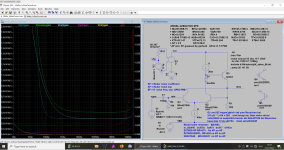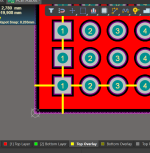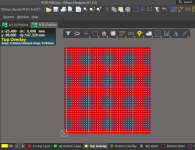Nobody likes this one?
One of the few remaining options for Bob Widlar's FET input replacement circuit.
It really needs super-beta transistors.
Q4 and Q5 are only parking lots.
cheers, Gerhard
Attachments
I have made a 100*100mm prototype board with GND and VCC planes.That used to be the home of some RF electronics made by Kathrein.
I bought half a dozen from ebay and emptied them. Top and bottom
plates are from steel. The proto board with ground mesh:
www.segor.de
That's even cheaper than the power plane boards available from Segor,
let alone BIC-Vero. Gerbers or Altium available.
JLCpcb did not even complain b/c of the many bore holes.
Attachments
I would only use the ZTX devices in an MC amplifier. Current noise is a big issue in MM amplifiers so a better choice is a JFET IPS.I've read that chapter, but still not sure if I got this right - ZTX851 has lowest noise with a current around 10mA. So probably circuit shall be altered to that. Also, it seems that the whole ZTX series is very low noise. I can get ZTX450 locally for reasonable price, what do you guys think about them?
Apparently Widlar hated JFETs 😳One of the few remaining options for Bob Widlar's FET input replacement circuit.
It really needs super-beta transistors.
Q4 and Q5 are only parking lots.
cheers, Gerhard
If JFET is an option, LSK389 from Linear System is top notch in terms of noise.
I built a pre-amp for a ribbon mic and it was amazing how quiet this JFET is.
You need to choose the optimal drain current to miminize noise.
If less noise is needed, you can parallel several JFET's.
I built a pre-amp for a ribbon mic and it was amazing how quiet this JFET is.
You need to choose the optimal drain current to miminize noise.
If less noise is needed, you can parallel several JFET's.
You learn to hate them if you need low input current AND the full
commercial / military temperature range.
< https://hackaday.com/2014/04/08/heroes-of-hardware-revolution-bob-widlar/ >
commercial / military temperature range.
< https://hackaday.com/2014/04/08/heroes-of-hardware-revolution-bob-widlar/ >
Hatred of JFETs prompted Widlar and his National Semiconductor amigos to develop the LM308A opamp, which used zero JFETs but several superbeta bipolars, and which achieved lower input leakage current than JFETs of the era. A surprising accomplishment, that their ads and their datasheets and their application notes bragged about ad infinitum. As @gerhard said: it's a specsmanship issue over the full temperature range.
2n5210 if you can find them I used those with an Lf353 to amplify a cassette head.
64db signal to noise Dolby off.
They are great if you can find them
I had the 700 beta version.
64db signal to noise Dolby off.
They are great if you can find them
I had the 700 beta version.
I am building a microphone preamp, so I presume current noise will not be a big deal?I would only use the ZTX devices in an MC amplifier. Current noise is a big issue in MM amplifiers so a better choice is a JFET IPS.
For a single-ended common-emitter type of input stage, neglecting 1/f noise, the following equation gives the optimal collector current. At this current, the voltage noise due to collector shot noise and the current noise due to the base shot noise have equal impacts.
IC,opt ~= (kT/q) • √hFE/(|Zs + rb|)
kT/q ~= 26 mV at room temperature
rb is the base resistance, which will be small when you use a good low-noise transistor
Zs is the source impedance, probably around 200 ohm for a typical dynamic microphone
For, for example, hFE = 625, the optimum collector current would be about 3.25 mA.
For an amplifier with differential input, you have to calculate with half the source impedance, so the optimal current per transistor almost doubles. For a single-ended amplifier with a differential pair as input stage, the optimal current per transistor is roughly √2 times the value that comes from the equation.
Mind you, noise optima are usually very broad, so when you are off by a factor of two, no one will notice the difference. You just shouldn't be off by decades.
IC,opt ~= (kT/q) • √hFE/(|Zs + rb|)
kT/q ~= 26 mV at room temperature
rb is the base resistance, which will be small when you use a good low-noise transistor
Zs is the source impedance, probably around 200 ohm for a typical dynamic microphone
For, for example, hFE = 625, the optimum collector current would be about 3.25 mA.
For an amplifier with differential input, you have to calculate with half the source impedance, so the optimal current per transistor almost doubles. For a single-ended amplifier with a differential pair as input stage, the optimal current per transistor is roughly √2 times the value that comes from the equation.
Mind you, noise optima are usually very broad, so when you are off by a factor of two, no one will notice the difference. You just shouldn't be off by decades.
Last edited:
Unless its a condensor mic high impedance buffer of course! Those are in the gigaohm range. Fortunately all condensor microphones incorporate a built-in buffer so you only have to worry about this if making your own microphones from scratch.I am building a microphone preamp, so I presume current noise will not be a big deal?
For optimal noise performance you want the ratio of voltage noise to current noise to be the same as the source impedance (or rather the absolute value of the complex source impedance to be precise). When a device's noise figure is quoted it is for a particular source impedance and standing current. Many devices have a plot of noise figure against current and source impedance which is useful for setting the optimum current for a particular situation (but little use for comparing devices). For comparing devices noise spectral density plots are more useful.
- Home
- Amplifiers
- Solid State
- Low noise bipolar transistors for audio?


